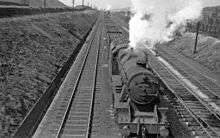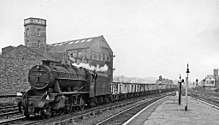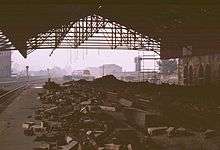Mirfield railway station
Mirfield railway station serves the town of Mirfield in West Yorkshire, England. It lies on the Huddersfield Line managed by Northern but also now served by Grand Central and is 4 miles (6 km) north east from Huddersfield.
| Mirfield | |
|---|---|
 The view from platform 3 | |
| Location | |
| Place | Mirfield |
| Local authority | Kirklees |
| Coordinates | 53.6716°N 1.6933°W |
| Grid reference | SE203195 |
| Operations | |
| Station code | MIR |
| Managed by | Northern |
| Number of platforms | 3 |
| DfT category | F1 |
| Live arrivals/departures, station information and onward connections from National Rail Enquiries | |
| Annual rail passenger usage* | |
| 2014/15 | |
| 2015/16 | |
| 2016/17 | |
| 2017/18 | |
| 2018/19 | |
| Passenger Transport Executive | |
| PTE | West Yorkshire Metro |
| Zone | 3 |
| History | |
| Original company | Manchester and Leeds Railway |
| Pre-grouping | Lancashire and Yorkshire Railway |
| Post-grouping | London, Midland and Scottish Railway |
| April 1845 | First station opened |
| 5 March 1866 | Station resited |
| National Rail – UK railway stations | |
| * Annual estimated passenger usage based on sales of tickets in stated financial year(s) which end or originate at Mirfield from Office of Rail and Road statistics. Methodology may vary year on year. | |
The platforms have an unusual configuration. Platforms 1 and 2 form an island platform on the western side of the bridge over Station Road/Hopton New Road. Trains from Platform 1 go to Leeds and Wakefield Westgate (eastbound); Platform 2 is rarely used for normal scheduled services but is passed by non-stopping westbound trains to Huddersfield. Platform 3 is a side platform on the eastern side of the bridge; trains are towards Huddersfield, Halifax, Bradford Interchange and Brighouse (westbound). The train to Leeds takes around 25 minutes and to reach Huddersfield takes around 10 minutes.
History



The town received its first railway in 1840, when the Manchester and Leeds Railway opened the first section of its cross-Pennine main line between Normanton and Hebden Bridge (completing it through to Manchester on 1 March 1841). It did not actually get a station though until April 1845,[1] when the company opened one shortly before submitting plans to Parliament to build a branch line from the town along the Spen Valley to Bradford via Cleckheaton. Approval was granted for the route the following year and it was opened as far as Low Moor on 12 July 1848 and through to Bradford two years later. By this time further lines had been opened from nearby Heaton Lodge Junction to Huddersfield by the Huddersfield & Manchester Railway (opened on 3 August 1847) and from Thornhill to Leeds by the Leeds, Dewsbury & Manchester Railway (opened 18 September 1848).[2] The LNWR (which had absorbed both the H&M and LD&M by 1849) had originally planned to build its own route through Mirfield, but after negotiations with the Lancashire and Yorkshire Railway (successors to the M&L) agreed to not to go ahead in return for the granting of running powers over the Thornhill to Heaton Lodge section (and also allowing the L&Y access to Huddersfield). This meant that the railway passing through the town soon became extremely congested, carrying as it did the traffic on two main trunk routes between Manchester and Leeds (the Huddersfield & Manchester company having completed its route through Stalybridge in August 1849) and it led to the station gaining a notorious reputation for delays. This persisted even after the Heaton Lodge - Thornhill section was quadrupled in 1884,[3] and it was not until the LNWR opened an alternative Huddersfield to Leeds route at the turn of the century that the situation began to improve. To facilitate interchange, a new station was built 202 yd (185 m) to the east of the original; the contract for the station (excluding roof) was placed on 25 May 1864, the roof contract being placed on 26 April 1865. The new station centred on a large island platform with overall roof, and facilities included a hotel, buffet and billiard room; it opened on 5 March 1866.[4][5]
Today the station remains busy, despite the loss of the Spen Valley service to Bradford from 14 June 1965[6] and the links to Normanton and York on 5 January 1970 (the line via Brighouse also closed at the same time, but this reopened in 2000 for peak hour services). It has also lost its buildings to demolition (in the mid-1980s) and one of its four tracks but gained the aforementioned third platform as part of a set of capacity improvements in the late 1980s.
Facilities
The station is unstaffed and has a ticket machine available on the platform. Digital display screens, timetable posters and automated announcements provide train running information. Shelters are provided on each platform, but only platform 3 has step-free access (from the station car park). Access to the older island platform is via a subway with stairs up to platform level.[7] Platform 3 is to be extended by December 2018 as part of a Network Rail plan to extend more than 100 platforms at 70 stations across the north of England.[8]
Services
Northern
Eastbound from Mirfield, an hourly service to Leeds and to Wakefield Kirkgate.[9]
Westbound hourly to Huddersfield, with connecting services at Huddersfield to Bradford Interchange, Penistone, Liverpool Lime Street and Manchester Airport. There is also an hourly daytime service to Manchester Victoria and Southport via Brighouse and Hebden Bridge - this was introduced as part of the December 2008 timetable alterations on the Calder Valley Line.[10]
There are no Northern services on a Sunday.
TransPennine Express
Since the May 2018 timetable change, TransPennine Express services now call here hourly each direction seven days per week. Eastbound trains serve most local stations to Leeds, whilst westbound trains call at Deighton and Huddersfield (direct services west of there ended at the December 2018 timetable change).
Grand Central – West Riding
The station now sees a number of direct services to London Kings Cross via Wakefield Kirkgate, Pontefract and Doncaster, which commenced on 23 May 2010. In January 2009, Grand Central Railway had their application for train paths to run a Bradford Interchange (via Halifax and Brighouse) to London service accepted by the Office of Rail Regulation. In the December 2017 timetable, four trains call in each direction throughout the week (including Sundays).[11]
Future
In February 2019, it was revealed that Mirfield was in line for a new station as part of the £3bn TransPennine Route Upgrade.[12]
Notes
- Bairstow 1983, p. 13
- Bairstow 1983, p. 14
- Bairstow 1983, p. 15
- Marshall 1969, pp. 226–7
- Butt 1995, p. 161
- Body 1988, p. 124
- Mirfield station facilities National Rail Enquiries; Retrieved 16 January 2017
- North of England Platform Extension Programme Network Rail press release; Retrieved 18 November 2018
- Table 39 National Rail timetable, May 2019
- GB eNRT, Table 41
- "West Yorkshire and Doncaster timetable – from 11 December 2016 to 20 May 2017" Grand Central; Retrieved 21 April 2016/
- Earnshaw, Tony (22 February 2019). "Mirfield "to get new station"". Telegraph & Argus. Retrieved 23 February 2019.
References
- Bairstow, M. (1983). The Manchester & Leeds Railway (The Calder Valley Line). Skipton: Wyvern Publishing. ISBN 0-907941-06-0.CS1 maint: ref=harv (link)
- Body, G. (1988). PSL Field Guides - Railways of the Eastern Region Volume 2. Wellingborough: Patrick Stephens Ltd. ISBN 1-85260-072-1.CS1 maint: ref=harv (link)
- Butt, R.V.J. (1995). The Directory of Railway Stations. Yeovil: Patrick Stephens Ltd. ISBN 1-85260-508-1. R508.CS1 maint: ref=harv (link)
- Marshall, John (1969). The Lancashire & Yorkshire Railway, volume 1. Newton Abbot: David & Charles. ISBN 0-7153-4352-1.CS1 maint: ref=harv (link)
External links
| Wikimedia Commons has media related to Mirfield railway station. |
- Train times and station information for Mirfield railway station from National Rail
| Preceding station | Following station | |||
|---|---|---|---|---|
| Deighton | TransPennine Express North TransPennine (Manchester - Leeds) |
Ravensthorpe | ||
| Northern Huddersfield Line (Huddersfield - Wakefield Kirkgate) |
Wakefield Kirkgate | |||
| Brighouse | Grand Central West Riding (Bradford Interchange - London Kings Cross) |
|||
| Northern Calder Valley Line (Southport - Leeds) |
Dewsbury |
Railways in North Kirklees | |||||||||||||||||||||||||||||||||||||||||||||||||||||||||||||||||||||||||||||||||||||||||||||||||||||||||||||||||||||||||||||||||||||||||||||||||||||||||||||||||||||||||||||||||||||||||||||||||||||||||||
|---|---|---|---|---|---|---|---|---|---|---|---|---|---|---|---|---|---|---|---|---|---|---|---|---|---|---|---|---|---|---|---|---|---|---|---|---|---|---|---|---|---|---|---|---|---|---|---|---|---|---|---|---|---|---|---|---|---|---|---|---|---|---|---|---|---|---|---|---|---|---|---|---|---|---|---|---|---|---|---|---|---|---|---|---|---|---|---|---|---|---|---|---|---|---|---|---|---|---|---|---|---|---|---|---|---|---|---|---|---|---|---|---|---|---|---|---|---|---|---|---|---|---|---|---|---|---|---|---|---|---|---|---|---|---|---|---|---|---|---|---|---|---|---|---|---|---|---|---|---|---|---|---|---|---|---|---|---|---|---|---|---|---|---|---|---|---|---|---|---|---|---|---|---|---|---|---|---|---|---|---|---|---|---|---|---|---|---|---|---|---|---|---|---|---|---|---|---|---|---|---|---|---|---|
Past, present and future | |||||||||||||||||||||||||||||||||||||||||||||||||||||||||||||||||||||||||||||||||||||||||||||||||||||||||||||||||||||||||||||||||||||||||||||||||||||||||||||||||||||||||||||||||||||||||||||||||||||||||||
| |||||||||||||||||||||||||||||||||||||||||||||||||||||||||||||||||||||||||||||||||||||||||||||||||||||||||||||||||||||||||||||||||||||||||||||||||||||||||||||||||||||||||||||||||||||||||||||||||||||||||||